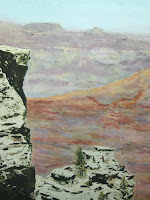
Cielo Vista
Acrylic on Canvas
30 x 24 in/76 x 61 cm
Copyright 2008
I got the digital image of the Grand Canyon acrylic I finished earlier in the week, so you can see how it turned out. I like it, and will shoot it over to Orbisplanis Online Art Gallery this weekend.
Just a reminder, Orbisplanis is a daily blog (M-F) with fresh content every day (unless I’m on vacation, of course, in which case I’ll tell you ahead of time). A good reason to visit Orbisplanis every day. Tell your friends and family, too.
Acrylic on Canvas
30 x 24 in/76 x 61 cm
Copyright 2008
I got the digital image of the Grand Canyon acrylic I finished earlier in the week, so you can see how it turned out. I like it, and will shoot it over to Orbisplanis Online Art Gallery this weekend.
Just a reminder, Orbisplanis is a daily blog (M-F) with fresh content every day (unless I’m on vacation, of course, in which case I’ll tell you ahead of time). A good reason to visit Orbisplanis every day. Tell your friends and family, too.
Orbisplanis Poll Results
Links We Hope You Like, Too
In the Library
For the premiere, I’ll start us off with How to Draw Anything by Mark Linley. This is a gem of a book for beginning sketchers and artists. It’s a great starting place. if you have recently moved from the I’m-thinking-about-doing-art stage to the I’m-actually-going-to-pick-up-a-pencil-and-draw-something stage, then you should read this first.
It starts off with a pep talk about anybody can learn to draw, with which you know, if you’ve been reading Orbisplanis, I wholeheartedly agree. Then—bang—right out of the gate, you are told, Start with Landscapes, the title of chapter 2. Get a pen [Orbisplanis suggests using a Rollerball pen], use black ink, draw a tree, and go, go, go. Go outside and, I’m quoting here, “churn them out.” A little about shapes, a little about shading, and practice, practice. And you’re off and running.
The next chapter is about drawing bridges, specifically stone bridges in the “countryside.” What!? The intent, I think, is to engage you right away with subjects that are just a little bit challenging to keep you occupied. He gives very practical advice, such as, you don’t need to draw every stone and rock, and how to dot-stipple for a realistic effect. “The more you draw, the better and quicker you become,” he says.
He has you going all over the place: to the woods, the hills, the seaside, to practice your drawing. Linley drops in a chapter here on drawing buildings and a chapter there on composition. He introduces the grid system about half-way into the book calling it “a useful little aid.” This is great stuff, especially for a beginning artist.
No subject being too difficult to draw, he has you drawing animals starting with a buffalo, no less. Then it’s on to sheep, cats, foxes, squirrels, horses, dogs, and birds. He gives lots of examples and simple lessons on such things as body shapes and birds in flight.
Ironically, there are eight chapters on drawing people. From what I pick up on, even experienced artisans think learning to draw people is an acquired skill. But Linley has you drawing heads, eyes, ears, noses, torsos, hair, right away. You will be able to draw a simple portrait if you practice. In showing you how to draw people, he builds your confidence, and that is most important.
But wait, there’s more. Want to draw cartoons, funny figures, funny things (like a walking book), greeting cards? Linley shows you how. So, to repeat myself, this is a gem of a book, and a great starting place for anyone who wants to simply learn to draw.
So what you want to do is read the book and practice, practice, practice.
In the Studio
If you like reading this blog, please leave a comment, and feel free to link this site to others who may have an interest.
Cheers!
I would like to add that, as far as learning to draw people goes, I would recommend practicing gesture drawing, or taking a course on gesture drawing. It helps you get a sense of movement and how weight is distributed over the figure in any given pose. A good book on this is Nicolaides' The Natural Way to Draw.
ReplyDeletePeople should read this.
ReplyDelete